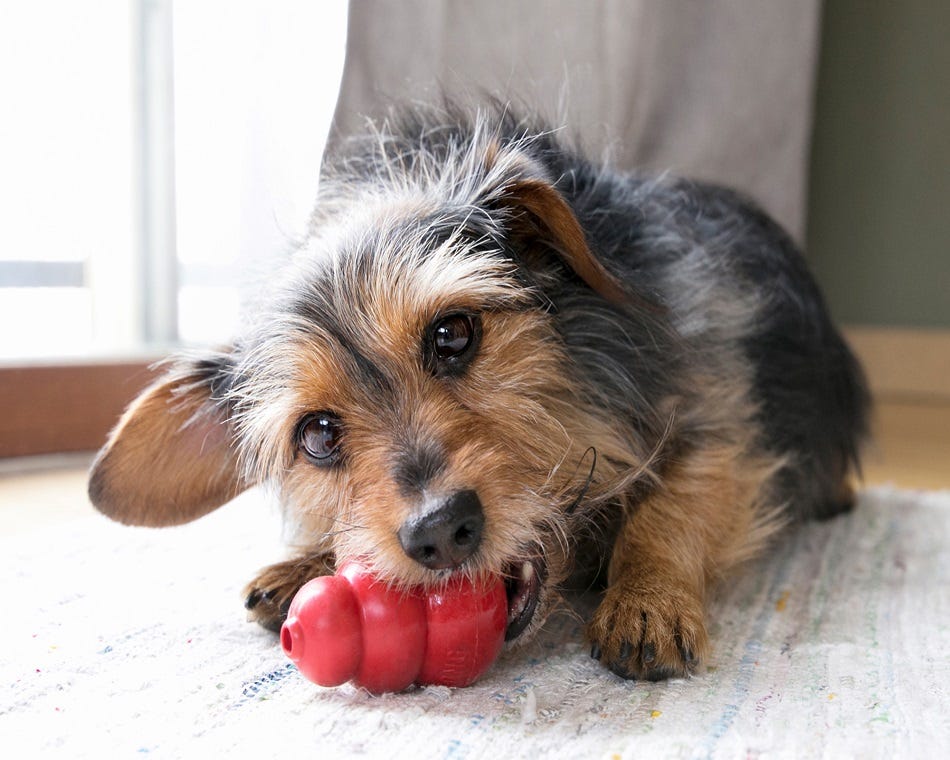The different puppy teething stages
Teething starts at an early age – sometimes before you even bring your new fur baby home. Puppies will go through teething twice before they hit the one-year mark. However, by learning all about the different stages, you’ll be able to prepare for each one.
| AGE | PUPPY TEETHING STAGE |
| 0 - 2 weeks | No teeth. |
| 3 - 4 weeks | First baby teeth grow in. A lot of pet parents won’t go through the newborn teething stage as puppies are generally adopted after 8 weeks of age. |
| 8 week | All baby teeth are generally grown in. Puppies usually have about 28 baby teeth in total. At this stage the puppy will be weaned and begin eating soft puppy food. |
| 3 - 5 months | As baby teeth begin to fall out, your pup might be in quite a bit of pain. You might find tiny, rice-sized teeth around your home. |
| 5 - 7 months | Adult teeth start to grow in, starting with incisors, then canines, premolars and molars. |
| 7 months | By this age, your puppy should have all 42 adult teeth. |
Teething puppy symptoms
Puppy teething isn’t tricky to identify. Sometimes you’ll begin finding teeth around the house or in their food. You might even witness your puppy losing teeth. However, there are other signs that your puppy’s adult teeth are growing in:
- Chewing and nipping
- Excessively drooling
- Small blood spots on your pup’s toys or in their food
- Red or swollen gums
- Fever
- Loss of appetite
- Crying or whining
- An irritable or low mood
While teething is a completely normal process, it’s best to head down to your local vet if you notice any of the following symptoms:
- A high fever that doesn’t break
- Large amounts of blood or bleeding
- Broken or wonky teeth
If you have any of these symptoms are presenting while your puppy is teething, please don't hesitate to contact your local Our Vet team.
What to give a teething puppy
During their teething, you’ll find that your puppy’s chewing habits may appear out of control. There are a few ways you can help out your friend. While you shouldn’t change their diet, you can make it easier to eat and more palatable for teething fur babies.
Soak their kibbles in warm water before serving to help soften it. You can also mix their wet food with their dry to make it more palatable. You might also find that frozen snacks like carrots will help ease the swelling in their gums. You can freeze toys like a KONG, and smother in peanut butter to give them a tasty, frozen treat.
Puppy teething toys
Toys can be a saviour for a teething puppy. A small splurge on a few trusted toys can help them through the teething process and keep your precious shoes and furniture safe. Your pup will likely be looking for something to gnaw on to help ease their pain. Look for toys that are made from softer materials, like:
To help both you and puppy through teething, owners should:
- If you see puppy chewing on something, he shouldn’t be chewing reprimand with an “AH AH” or “NO” and always replace the item with a toy or chew treat so your puppy knows what you want him to chew on.
- Soak a rope toy in water and freeze it before offering it to your puppy, the cold helps to ease the pain and swelling that comes with teething.
- Offer a few different toys with different textures as chewing massages the puppy’s gums and reduces the pain that he is experiencing from teething. It also helps to loosen the puppy teeth so they can come out and breaks the skin on the gum to allow the adult tooth to come through.
- Deterrents and bitter sprays are available, and when sprayed on items such as furniture and bedding can stop puppy from chewing. Always test a small area first or it could make the problem worse.
- Rotate toys so pup doesn’t get bored and is more likely to chew the toys.
- Supervise! If you can’t watch your puppy place him in a safe area such as a crate with some chew toys.
Avoid toys that your pup can easily rip apart, like a plush toy, and always make sure you supervise them to avoid them swallowing and choking on small objects.
Puppy proof your home
While your house should be relatively puppy-proof, teething can be a great opportunity to take another look around for potentially dangerous items. Look at gating off rooms, covering wires and cords and keeping objects like towels or soft blankets out of reach.
As they’re teething, your puppy will likely want to chew on whatever they can reach. Make sure you take note of potentially toxic items, like plants, foods and drinks that aren’t safe for our fur babies.
How to stop puppy biting
You might find your puppy biting and nipping more than usual during teething. You want to ensure that puppy nipping doesn’t become a lifelong habit.
Pull your hand or body part away with a loud yelp, teaching them to not to do it again. If your pup is still worked up, you can either walk away from them or pop them in their crate to calm them down.
When your pup bites when teething, it’s often to help relieve their pain. You can always redirect this biting to one of their toys, rewarding them when they begin to chew on that instead.
Puppy teething is a completely normal stage of puppyhood. If you’re lucky, your furry friend will breeze through teething with just a few minor symptoms. Some other pups aren’t as fortunate and will experience some discomfort and even pain as their adult puppy teeth grow.
Puppy Teething FAQ:
When do puppy teeth fall out?
Your puppy’s teeth will start to fall out around 3 months of age. However, some puppies can take a little longer – up to 5 months – before their teeth start falling out.
When do puppies stop teething?
By 7 months of age, your puppy should have all of their adult teeth.
What can you give a teething puppy for pain?
There are plenty of ways you can help your pup through their teething – from specific toys to softened food or frozen treats. If your puppy’s pain doesn’t let up, always take them to a trusted vet for more advice on how you can help them.




